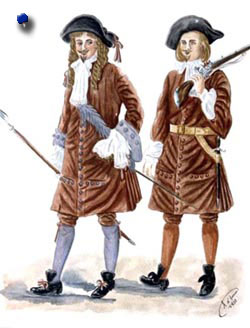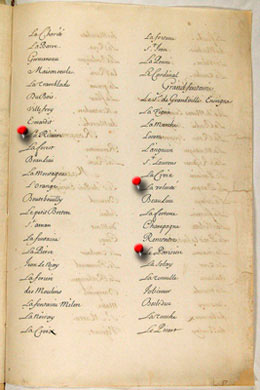Régiment de Carignan-Salières.
In Defense of the Colony.
When settling new lands it cannot be denied that in moving in, existing occupants are moved out. When Cartier first approached Hochelaga (Montréal) in 1535 he described a thriving village of over 1,000. The village was abandoned by his return in 1541, whether due to disease or war or some other unknown reason. For his part, Champlain stood against the Iroquois in 1609, in favor of local tribes, and forever earned their animosity. It was a decision that reverberated for the French until they at last lost the colony to the next conquering nation.

Attacks by the Iroquois plagued the settlements along the north shore of the Saint Lawrence River. Ancestors including Pierre Forcier, Denise Lemaítre and Jean Lanctôt met death at their hands. At about 240 residents in 1641, New France was sparsely populated by Europeans, and did not compare favorably with the over 26,000 in British Colonial America. The years between 1646 and 1653 saw the burning of Fort Richelieu and the demise of the Hurons and French missionaries in the adjoining territories. During the bloody Beaver Wars of the mid-17th century the British and Dutch armed the Iroquois who sought to defeat the French and their Algonquian allies.
So as much to protect economic interests as to save the settlers, French finance minister Jean-Baptiste Colbert ordered le régiment de Carignan-Salières to reinforce the meager 100 or so currently defending the country. The crown was expected to pay the soldiers wages, but the colonel, a wealthy man, provided for their food and equipment and it was for him that the group was named. The regiment had been formed by combining the Balthasar Regiment (which was taken over by Salières upon the death of Balthasar in 1665) and the Carignan Regiment.
The regiment wore uniforms of brown coats with cuffs in contrasting colors. Slouch hats better repelled the weather, but even so were replaced by tri-corn hats in later years. The men were poorly equipped in the first year, with far fewer flintlocks and pistols than required. It was one of the first groups to employ the use of bayonets. Swords were provided for situations which required hand-to-hand combat. Soldiers were often billeted in the homes of the settlers, who were obliged to provide a warm place for them to sleep.
The men adopted noms de guerre like those used by our ancestors, La Plante, Le Parisien or La Fleur. It was a volunteer army, young men eager to enlist in hopes of escaping poverty or even to become a nobleman by rising through the ranks based on merit.
The Companies.
Over one thousand men in twenty companies were dispatched, sailing in seven ships. Their first campaign was in the winter of 1666. They were largely successful in promoting the peace which began in 1667 and lasted for roughly 20 years. Most of the men returned to France, but many stayed on accepting land grants and raising families.
A lineage chart of the Regiment may be found here: Carignan-Salières chart.
Our grandfathers who were part of this endeavor are listed below with their company and the ship they likely sailed on.
Contrecœur.
Under the command of Antoine Pécaudy, Sieur de Contrecœur the company along with 3 others departed from La Rochelle in May aboard the brigantine La Paix and arrived in Québec the evening of 18 August 1665. They were sent on to Montréal.
Froment.
The soldiers aboard the chartered Dutch ship Vieux Simeon departed La Rochelle the 19th of April and docked in Quebec the 19th of June 1665. They were under the command of Captain Pierre-André de Froment. First sent to Trois-Rivières where they wintered, in July they were charged with the construction of Fort Saint-Louis (later known as Chambly).

Grandfontaine.
Hector d' Andigné de Grandfontaine was the captain of this company which boarded L' Aigle d' Or on May 13 in La Rochelle as part of the second contingent sent over. The Royal ship was quite old and had a worm eaten hull which was not water tight. They travelled with La Paix arriving in Québec the night of the 18th of August 1665 where they spent the winter. They participated in constructing Fort Sainte-Thérèse and in building the road along the Richelieu river connecting Fort Sainte-Thérèse and Fort Saint-Louis (later known as Chambly). The company campaigned against the Mohawks the following year.
La Fouille.
This company boarded the le Justice with captain Jean-Maurice-Philippe de Vernon, Sieur de la Fouille. The ship, which was armed with 28 canons, departed 24 May but did not arrive in Québec until 12 September 1665. The colony's new governor Daniel de Rémy de Courcelle and Intendent Jean Talon also made the voyage. It crossed the ocean with Saint-Sébastien.
Laubia
Arnoult de Laubias was the captain of this company which travelled aboard the le Justice following the royal ship Saint-Sébastien. Among the cargo were 10 barrels of brandy and 400 axes. The axe was de rigueur for survival in the frontier, and since guns were in short supply the axe would serve as the weapon of choice. The lengthy voyage of 117 days saw the death of about 20 men between the two ships. After a stop in Tadoussac to take on pilots who could navigate the Saint-Lawrence, about 100 men were found to be ill according to a letter to the King from Intendent Jean Talon. They made it to port in ville de Québec 12 September 1665. Over a hundred were too weak to make it off the ship unassisted. This group was assigned to Trois-Rivières. Laubias remained there until 10 June 1668.
Saint-Ours.
Under the command of Captain Pierre de Saint-Ours, sieur de l'Eschaillon, this company sailed 24 May on le Justice. They landed in Québec on the 14th of September 1665 and wintered at Fort Sorel.
- https://www.statcan.gc.ca/pub/98-187-x/4151287-eng.htm#5 240 colonists in 1641
- https://www.infoplease.com/ipa/A0004979.html in 1640 the estimated population of Colonial America was about 26,600
- Our French Canadian Ancestors by Thomas J. Laforest
- Note: Numerous discrepencies were found in various sources regarding the rolls of the soldiers, and the ships in which they were transported
- https://www.oocities.org/~carignan/09_Nav_Carignan/E9nav_car.html (accessed 10/01/01)
- Le Regiment de Carignan 1665-1668, G.-Robert Gareau, Juillet 2001
- Regiment de Carignan-Salieres, 1665 par A. d'Auriac — images.banq.qc.ca - pistard.banq.qc.ca. Sous licence Domaine public via Wikimedia Commons - https://commons.wikimedia.org/wiki/File:Regiment_de_Carignan-Salieres,_1665.jpg#/media/File:Regiment_de_Carignan-Salieres,_1665.jpg
- Rolle des Soldats du Regiment de Carignan-Salieres qui se sont faits habitans de Canada en 1668 - 03 par FR CAOM COL D2C 47 fol. 45-49vo — Champlain2004 org Sous licence Domaine public via Wikimedia Commons - https://commons.wikimedia.org/wiki/File:Rolle_des_Soldats_du_Regiment_de_Carignan-Salieres_qui_se_sont_faits_habitans_de_Canada_en_1668_-_03.jpg#/media/File:Rolle_des_Soldats_du_Regiment_de_Carignan-Salieres_qui_se_sont_faits_habitans_de_Canada_en_1668_-_03.jpg
- https://fillesduroi.org/cpage.php?pt=8
- https://mesancetres.ca/en/
- https://www.migrations.fr/le_st_sebastien_1665_anglais.htm
- https://www.geni.com/projects/Passagers-du-Saint-S%25C3%25A9bastien-1665/25021
- Guertin Story
